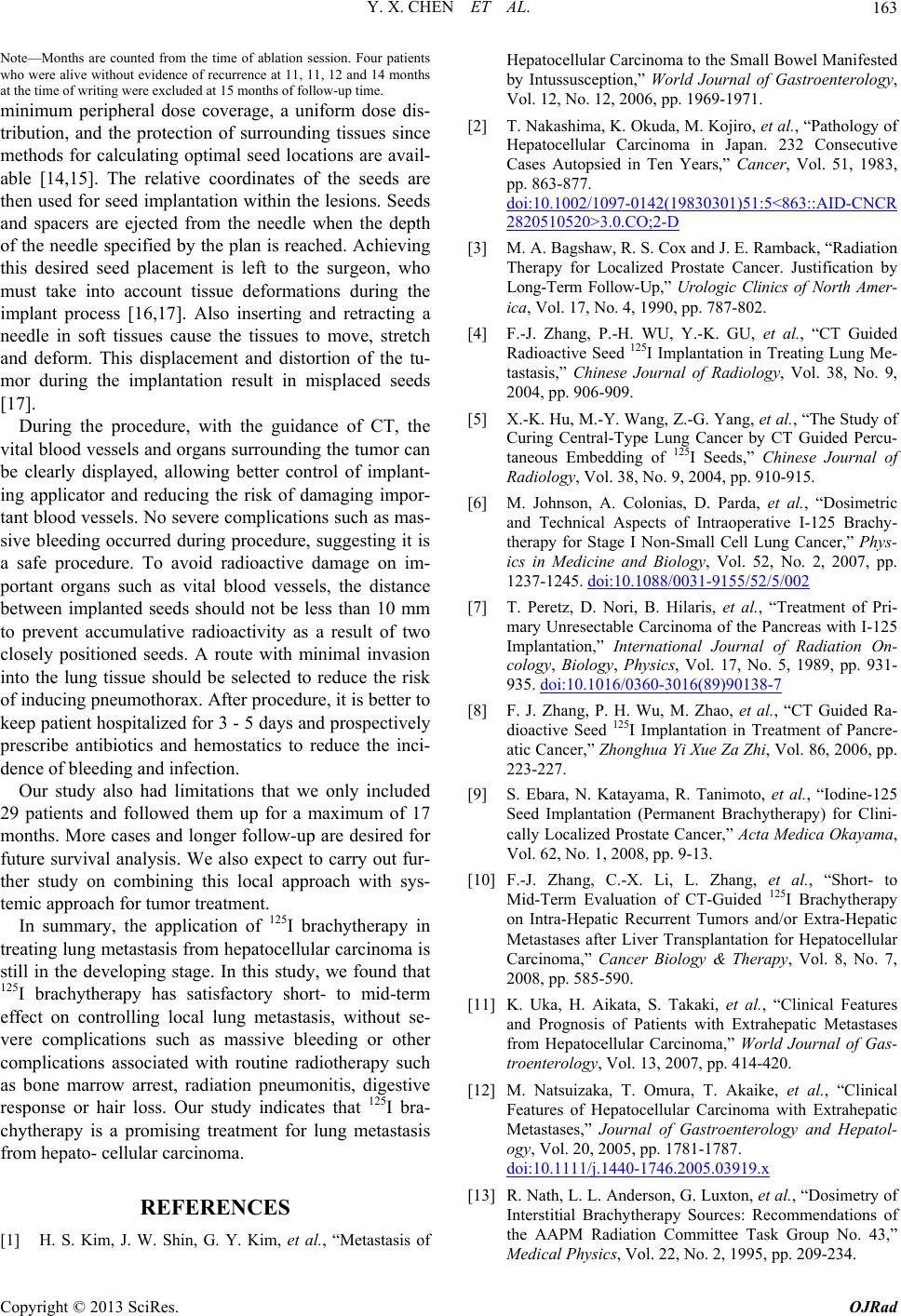
Y. X. CHEN ET AL. 163
Note—Months are counted from the time of ablation session. Four patients
who were alive without evidence of recurrence at 11, 11, 12 and 14 months
at the time of writing were excluded at 15 months of follow-up time.
minimum peripheral dose coverage, a uniform dose dis-
tribution, and the protection of surrounding tissues since
methods for calculating optimal seed locations are avail-
able [14,15]. The relative coordinates of the seeds are
then used for seed implantation within the lesions. Seeds
and spacers are ejected from the needle when the depth
of the needle specified by the plan is reached. Achieving
this desired seed placement is left to the surgeon, who
must take into account tissue deformations during the
implant process [16,17]. Also inserting and retracting a
needle in soft tissues cause the tissues to move, stretch
and deform. This displacement and distortion of the tu-
mor during the implantation result in misplaced seeds
[17].
During the procedure, with the guidance of CT, the
vital blood vessels and organs surrounding the tumor can
be clearly displayed, allowing better control of implant-
ing applicator and reducing the risk of damaging impor-
tant blood vessels. No severe complications such as mas-
sive bleeding occurred during procedure, suggesting it is
a safe procedure. To avoid radioactive damage on im-
portant organs such as vital blood vessels, the distance
between implanted seeds should not be less than 10 mm
to prevent accumulative radioactivity as a result of two
closely positioned seeds. A route with minimal invasion
into the lung tissue should be selected to reduce the risk
of inducing pneumothorax. After procedure, it is better to
keep patient hospitalized for 3 - 5 days and prospectively
prescribe antibiotics and hemostatics to reduce the inci-
dence of bleeding and infection.
Our study also had limitations that we only included
29 patients and followed them up for a maximum of 17
months. More cases and longer follow-up are desired for
future survival analysis. We also expect to carry out fur-
ther study on combining this local approach with sys-
temic approach for tumor treatment.
In summary, the application of 125I brachytherapy in
treating lung metastasis from hepatocellular carcinoma is
still in the developing stage. In this study, we found that
125I brachytherapy has satisfactory short- to mid-term
effect on controlling local lung metastasis, without se-
vere complications such as massive bleeding or other
complications associated with routine radiotherapy such
as bone marrow arrest, radiation pneumonitis, digestive
response or hair loss. Our study indicates that 125I bra-
chytherapy is a promising treatment for lung metastasis
from hepato- cellular carcinoma.
REFERENCES
[1] H. S. Kim, J. W. Shin, G. Y. Kim, et al., “Metastasis of
Hepatocellular Carcinoma to the Small Bowel Manifested
by Intussusception,” World Journal of Gastroenterology,
Vol. 12, No. 12, 2006, pp. 1969-1971.
[2] T. Nakashima, K. Okuda, M. Kojiro, et al., “Pathology of
Hepatocellular Carcinoma in Japan. 232 Consecutive
Cases Autopsied in Ten Years,” Cancer, Vol. 51, 1983,
pp. 863-877.
doi:10.1002/1097-0142(19830301)51:5<863::AID-CNCR
2820510520>3.0.CO;2-D
[3] M. A. Bagshaw, R. S. Cox and J. E. Ramback, “Radiation
Therapy for Localized Prostate Cancer. Justification by
Long-Term Follow-Up,” Urologic Clinics of North Amer-
ica, Vol. 17, No. 4, 1990, pp. 787-802.
[4] F.-J. Zhang, P.-H. WU, Y.-K. GU, et al., “CT Guided
Radioactive Seed 125I Implantation in Treating Lung Me-
tastasis,” Chinese Journal of Radiology, Vol. 38, No. 9,
2004, pp. 906-909.
[5] X.-K. Hu, M.-Y. Wang, Z.-G. Yang, et al., “The Study of
Curing Central-Type Lung Cancer by CT Guided Percu-
taneous Embedding of 125I Seeds,” Chinese Journal of
Radiology, Vol. 38, No. 9, 2004, pp. 910-915.
[6] M. Johnson, A. Colonias, D. Parda, et al., “Dosimetric
and Technical Aspects of Intraoperative I-125 Brachy-
therapy for Stage I Non-Small Cell Lung Cancer,” Phys-
ics in Medicine and Biology, Vol. 52, No. 2, 2007, pp.
1237-1245. doi:10.1088/0031-9155/52/5/002
[7] T. Peretz, D. Nori, B. Hilaris, et al., “Treatment of Pri-
mary Unresectable Carcinoma of the Pancreas with I-125
Implantation,” International Journal of Radiation On-
cology, Biology, Physics, Vol. 17, No. 5, 1989, pp. 931-
935. doi:10.1016/0360-3016(89)90138-7
[8] F. J. Zhang, P. H. Wu, M. Zhao, et al., “CT Guided Ra-
dioactive Seed 125I Implantation in Treatment of Pancre-
atic Cancer,” Zhonghua Yi Xue Za Zhi, Vol. 86, 2006, pp.
223-227.
[9] S. Ebara, N. Katayama, R. Tanimoto, et al., “Iodine-125
Seed Implantation (Permanent Brachytherapy) for Clini-
cally Localized Prostate Cancer,” Acta Medica Okayama,
Vol. 62, No. 1, 2008, pp. 9-13.
[10] F.-J. Zhang, C.-X. Li, L. Zhang, et al., “Short- to
Mid-Term Evaluation of CT-Guided 125I Brachytherapy
on Intra-Hepatic Recurrent Tumors and/or Extra-Hepatic
Metastases after Liver Transplantation for Hepatocellular
Carcinoma,” Cancer Biology & Therapy, Vol. 8, No. 7,
2008, pp. 585-590.
[11] K. Uka, H. Aikata, S. Takaki, et al., “Clinical Features
and Prognosis of Patients with Extrahepatic Metastases
from Hepatocellular Carcinoma,” World Journal of Gas-
troenterology, Vol. 13, 2007, pp. 414-420.
[12] M. Natsuizaka, T. Omura, T. Akaike, et al., “Clinical
Features of Hepatocellular Carcinoma with Extrahepatic
Metastases,” Journal of Gastroenterology and Hepatol-
ogy, Vol. 20, 2005, pp. 1781-1787.
doi:10.1111/j.1440-1746.2005.03919.x
[13] R. Nath, L. L. Anderson, G. Luxton, et al., “Dosimetry of
Interstitial Brachytherapy Sources: Recommendations of
the AAPM Radiation Committee Task Group No. 43,”
Medical Physics, Vol. 22, No. 2, 1995, pp. 209-234.
Copyright © 2013 SciRes. OJRad